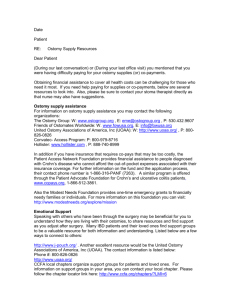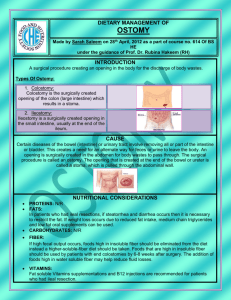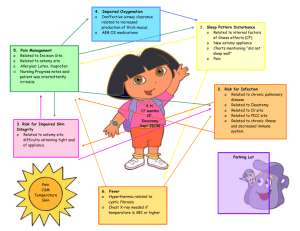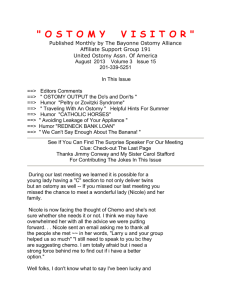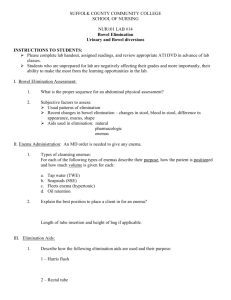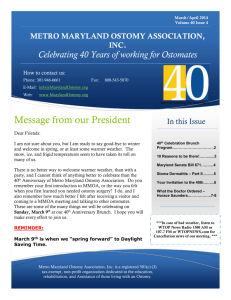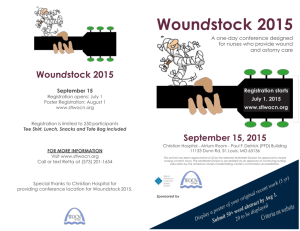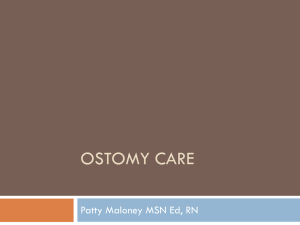Quality of Life Questionnaire for a Patient with an Ostomy
advertisement
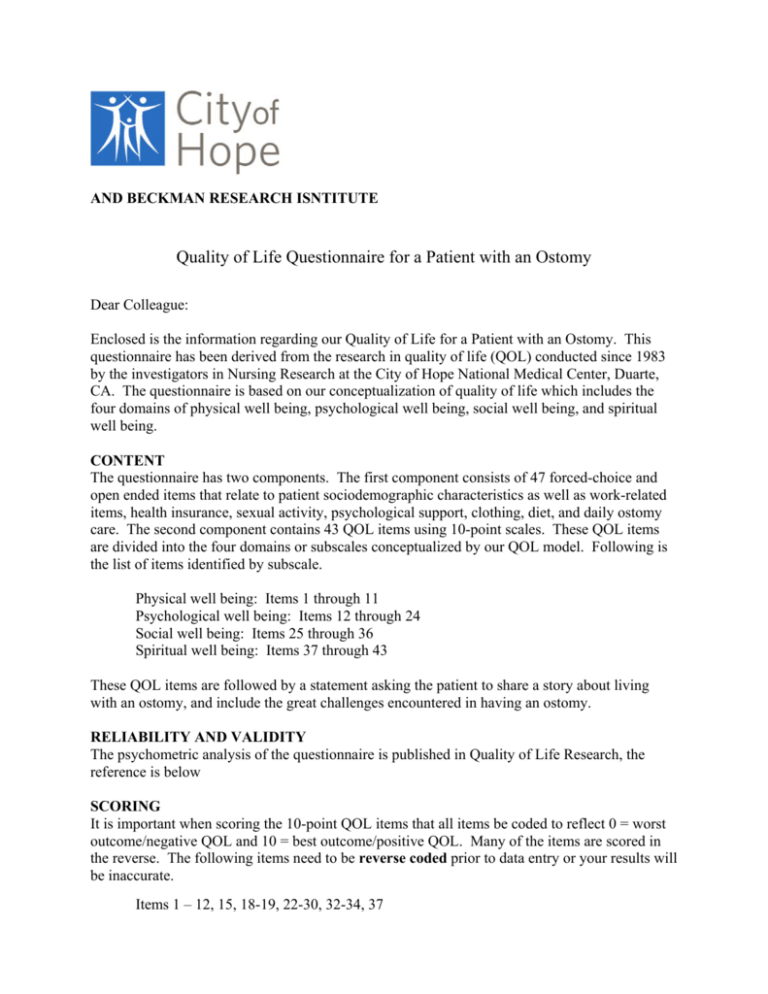
AND BECKMAN RESEARCH ISNTITUTE Quality of Life Questionnaire for a Patient with an Ostomy Dear Colleague: Enclosed is the information regarding our Quality of Life for a Patient with an Ostomy. This questionnaire has been derived from the research in quality of life (QOL) conducted since 1983 by the investigators in Nursing Research at the City of Hope National Medical Center, Duarte, CA. The questionnaire is based on our conceptualization of quality of life which includes the four domains of physical well being, psychological well being, social well being, and spiritual well being. CONTENT The questionnaire has two components. The first component consists of 47 forced-choice and open ended items that relate to patient sociodemographic characteristics as well as work-related items, health insurance, sexual activity, psychological support, clothing, diet, and daily ostomy care. The second component contains 43 QOL items using 10-point scales. These QOL items are divided into the four domains or subscales conceptualized by our QOL model. Following is the list of items identified by subscale. Physical well being: Items 1 through 11 Psychological well being: Items 12 through 24 Social well being: Items 25 through 36 Spiritual well being: Items 37 through 43 These QOL items are followed by a statement asking the patient to share a story about living with an ostomy, and include the great challenges encountered in having an ostomy. RELIABILITY AND VALIDITY The psychometric analysis of the questionnaire is published in Quality of Life Research, the reference is below SCORING It is important when scoring the 10-point QOL items that all items be coded to reflect 0 = worst outcome/negative QOL and 10 = best outcome/positive QOL. Many of the items are scored in the reverse. The following items need to be reverse coded prior to data entry or your results will be inaccurate. Items 1 – 12, 15, 18-19, 22-30, 32-34, 37 Subscale scores are produced by adding the scores on each item with the subscale and then dividing by the number of items in that subscale. A total QOL score is obtained by adding the scores on all 10-point items and dividing by the total number of items (43). Other versions of the City of Hope Quality of Life Questionnaire for a Patient with an Ostomy have been created for the VA population and the Kaiser Permanente population. The Kaiser version also includes a questionnaire for colorectal cancer patients without an ostomy. To get information about these questionnaires contact robert.krouse@va.gov and cc mary.wagner@va.gov. USING THIS QUESTIONNAIRE You are welcome to use our questionnaire. We require no further request for permission. You have permission to duplicate this questionnaire. And, good luck with your research!! Marcia Grant, RN, DNSc, FAAN Director and Professor Nursing Research and Education City of Hope National Medical Center 1500 East Duarte Rd. Duarte, CA 91010 References Gemmill, R., Sun, V., Ferrell, B. R., Krouse, R. S., & Grant, M. (2010). Going with the flow: Quality-of-life outcomes of cancer survivors with urinary diversion. Journal of Wound, Ostomy and Continence Nurses Society, 37(1), 65-72. Krouse, R., Grant, M., Ferrell, B. R., Dean, G., Nelson, R., & Chu, D. (2007). Quality of life outcomes in 599 cancer and non-cancer patients with colostomies. Journal of Surgical Research, 138(1), 79-87. DOI:10.1016/j.jss.2006.04.033. Grant, M., Ferrell, B. R., Dean, G., Uman, G., Chu, D., & Krouse, R. (2004). Revision and psychometric testing of the City of Hope quality of life-ostomy questionnaire. Quality of Life Research, 13(8), 1445-1457. DOI:10.1023/B:QURE.0000040784.65830.9f. Ostomy and CRC Publications Lundy, J. J., Coons, S. J., Wendel, C., Hornbrook, M. C., Herrinton, L., Grant, M., & Krouse, R. S. (2009). Exploring household income as a predictor of psychological well-being among longterm colorectal cancer survivors. Quality of Life Research, 18(2), 157-161. Krouse, R. S., Grant, M., Rawl, S. M., Mohler, M. J., Baldwin, C. M., Coons, S. J., McCorkle, R., Schmidt, C.M., & Ko, C. Y. (2009). Coping and acceptance: The greatest challenge for veterans with intestinal stomas. Journal of Psychosomatic Research, 66(3), 227-233. Pittman, J., Rawl, S.M, Schmidt, C. M., Grant, M., Ko, C. Y., Wendel, C., & Krouse, R. S. (2008). Demographic and clinical factors related to ostomy complications and quality of life in veterans with an ostomy. Journal of Wound, Ostomy and Continence Nursing, 35(5), 493-503. Baldwin, C. M., Grant, M., Wendel, C., Rawlk S., Schmidt, C. M., Ko, C., & Krouse, R. S. (2008). Influence of intestinal stoma on spiritual quality of life of US Veterans. Journal of Holistic Nursing, 26(3), 185-194. Mohler, M. J., Coons, S. J., Hornbrook, M. C., Herrinton, L. J., Wendel, C. S., Grant, M., & Krouse, R. S. (2008). The health-related quality of life in long-term colorectal cancer survivors study: Objectives, methods and patient sample. Current Medical Research and Opinions, 24(7), 2059-2070. McMullen, C. K., Hornbrook, M. C., Grant, M., Baldwin, C. M., Wendel, C. S., Mohler, M. J., Altschuler, A., Ramirez, M., & Krouse, R. S. (2008). The greatest challenges reported by longterm colorectal cancer survivors with stomas. The Journal of Supportive Oncology, 6(4), 175182. Krouse, R., Grant, M., Ferrell, B. R., Dean, G., Nelson, R., & Chu, D. (2007). Quality of life outcomes in 599 Cancer and non-cancer patients with colostomies. Journal of Surgical Research, 138(1), 79-87. Krouse, R. S., Grant, M., Wendel, C. S., Mohler, M. J., Rawl, S. M., Baldwin, C, M., Coons, S. J., McCorkle, R., Ko, C. Y., & Schmidt, C. M. (2007). A mixed-methods evaluation of healthrelated quality of life for male veterans with and without intestinal stomas. Diseases of the Colon and Rectum, 50(12), 2054-2066. Jain, S., McGory, M. L., Ko, C. Y., Sverdlik, A., Tomlinson, J. S., Wendel, C. S., Coons, S. J., Rawl, S. M., Schmidt, C. M., Grant, M,, McCorkle, R., Mohler, M. J., Baldwin, C. M., & Krouse, R. S. (2007). Comorbidities play a larger role in predicting quality of life compared to having an ostomy. American Journal of Surgery, 194(6), 774-779. Mitchell, K. A., Rawl, S. M., Schmidt, C. M., Grant, M., Ko, C. Y., Baldwin, C. M., Wendel, C., & Krouse, R. S. (2007). Demographic, clinical, and quality of life variables related to embarrassment in veterans living with an intestinal stoma. Journal of Wound, Ostomy and Continence Nursing, 34(5), 524-532. Coons, S. J., Chongpison, Y., Wendel, C. S., Grant, M., & Krouse, R. S. (2007). Overall quality of life and difficulty paying for ostomy supplies in the veterans affairs ostomy health-related quality of life study: An exploratory analysis. Medical Care, 45(9), 891-895. Grant, M., Ferrell, B. R., Dean, G., Uman, G., Chu, D., & Krouse, R. S. (2004). Revision and psychometric testing of the City of Hope quality of life – ostomy questionnaire. Quality of Life Research, 13(8), 1445-1457. ID# 0 CITY OF HOPE NATIONAL MEDICAL CENTER QUALITY OF LIFE QUESTIONNAIRE FOR PATIENTS WITH AN OSTOMY In advance, thank you for taking the time to complete this questionnaire. We want to ensure that your responses are anonymous. Your completed questionnaire is mailed directly to the Department of Nursing Research at City of Hope where an identification number will be assigned to the questionnaire. This front sheet will be separated from the questionnaire. Name ___________________________________ A current address, if changes have occurred. ___________________________________ ___________________________________ Current telephone number including area code _____________________________________ Date ___________________________ ID# 1 CITY OF HOPE NATIONAL MEDICAL CENTER QUALITY OF LIFE QUESTIONNAIRE FOR PATIENTS WITH AN OSTOMY Demographic Information Following are some questions about yourself. 1. What kind of Ostomy do you have? (Check (√) all that apply) ileostomy ______ colostomy ______ urinary diversion ______ 2. If you have a colostomy, is it permanent? ______ or temporary? ______ 3. If you have a urinary diversion, do you wear a bag at all times? No ______ Yes ______ 4. What illness or diagnosis led to your need for an ostomy? __________________________ 5. If cancer was the reason for your ostomy, please specify the type of cancer. ____________________________________________________________ 6. For how many months/years have you had your ileostomy? ______ colostomy? ______ urinary diversion? ______ 7. What is your gender? Male ______ Female ______ 8. What is your current age? ______ 9. What is your height? ______ 10. What is your current weight? ______ 11. What is your ethnicity? African American ______ American Indian ______ Asian ______ Black _______ Caucasian ______ Hispanic ______ Other ___, please specify ___________________ 12. What was your marital status prior to the surgery for your ostomy? Single ______ Married ______ Divorced ______ Widowed ______ Separated ______ 13. What is your marital status now? Single ______ Married ______ Divorced ______ Widowed ______ Separated ______ ID# 2 For the following questions, please answer NO, YES, or NA (NOT APPLICAABLE) by placing a check mark (√) in the appropriate column. No Work Related Items 14. Are you working full-time? 15. Are you working part-time? 16. Are you retired 17. Are you working in the same occupation that you had before your ostomy? 18. If you are not working in the same occupation as before your ostomy, was the change related to having an ostomy? Health Insurance 19. Do you currently have health insurance? 20. Have you had difficulty getting health insurance? 21. Have you had difficulty maintaining your health insurance? 22. Does your insurance pay all costs for your ostomy supplies? 23. Does your insurance pay part of the costs for your ostomy supplies? Sexual activity 24. Were you sexually active before getting your ostomy? 25. Have you resumed sexual activity since having your ostomy? 26. Is your sexual activity satisfying? 27. If you are male, do you have a problem getting an erection or keeping an erection? Yes NA ID# 3 No Yes NA Psychological Support/Concerns 28. Were you depressed after having your ostomy? 29. Since having your ostomy, have you ever considered or attempted suicide? 30. Do you belong to an ostomy support group? 31. Do you belong to another kind of support group? 32. Have you had the opportunity to talk with someone else who was going to have or had a new ostomy? Clothing 33. Does the location of your ostomy cause you problems? 34. Have you changed the style of clothing you wear because of your ostomy? Diet 35. Do you adjust your diet because of your ostomy? 36. Do you change your diet to prevent passing gas in public? Please answer the following questions in relation to the amount of time since the surgery for your ostomy. Your choices are MONTHS, YEARS, or NEVER. Please place a check mark (√) in the appropriate column. Months Years Never 37. How long was it before you felt comfortable with your daily ostomy care? 38. How long was it before you felt comfortable with your diet? 39. Hoe long was it before your appetite returned? ID# 4 For the following questions, please answer NO, YES, or NA (NOT APPLICABLE – meaning that you do not drink or eat these foods) by placing a check mark (√) in the appropriate column. Food Groups 40. I avoid drinking carbonated beverages. 41. I avoid eating dairy products. 42. I avoid eating fruits. 43. I avoid eating snacks. 44. I avoid eating vegetables. No Yes NA Following are some questions related to the care of your ostomy. Please write in your answers. 45. On the average, how long does it take to do your daily ostomy care? __________________________ 46. If you wear a pouch, please identify the brand name. _______________________________________ 47. If you wear a pouch AND have encountered any problems with it, please explain what those problems are/were. ___________________________________________________________________________________ ___________________________________________________________________________________ ___________________________________________________________________________________ ___________________________________________________________________________________ ID# 5 Directions: We are interested in knowing how the experience of having an ostomy affects your quality of life. Please answer all of the following questions based on your life at this time. Please circle the number form 0 – 10 that best describes your experiences. For example: How difficult is it for you to climb stairs? Not at all difficult 0 1 2 3 4 5 6 7 8 9 10 extremely difficult Circling (2) means you have some but not a lot of difficulty climbing stairs. Related to your ostomy, to what extent are the following a problem for you? 1. Physical strength no problem 0 2. 9 10 severe problem 1 2 3 4 5 6 7 8 9 10 severe problem 1 2 3 4 5 6 7 8 9 10 severe problem 2 3 4 5 6 7 8 9 10 severe problem 1 2 3 4 5 6 7 8 9 10 severe problem 1 2 3 4 5 6 7 8 9 10 severe problem 1 2 3 4 5 6 7 8 9 10 severe problem 1 2 3 4 5 6 7 8 9 10 severe problem 1 2 3 4 5 6 7 8 9 10 severe problem 8 9 10 severe problem 1 Diarrhea no problem 0 10. 8 Constipation no problem 0 9. 7 Odor no problem 0 8. 6 Gas no problem 0 7. 5 Aches or pains no problem 0 6. 4 Sleep disorders no problem 0 5. 3 Skin surrounding the ostomy no problem 0 4. 2 Fatigue no problem 0 3. 1 Leaking from the pouch (or around the appliance) no problem 0 1 2 3 4 5 6 7 ID# 6 11. Overall physical well-being no problem 0 12. 15. 10 severe problem 0 1 2 3 4 5 6 7 8 9 10 a great deal How much satisfaction or enjoyment in life do you feel? none at all 0 1 2 3 4 5 6 7 8 9 10 a great deal How useful do you feel? 0 1 2 3 How much are you embarrassed by your ostomy? 0 1 2 3 4 5 6 7 8 9 10 extremely embarrassed 6 7 8 9 10 excellent 6 7 8 9 10 excellent 6 7 8 9 10 extremely difficult 8 9 10 extremely difficult How good is your overall quality of life? 0 1 2 3 4 5 How is your ability to remember things? 0 1 2 3 4 5 How difficult is it to look at your ostomy? 0 1 2 3 4 5 How difficult is it for you to care for your ostomy? 0 1 2 3 4 5 6 7 Do you feel like you are in control of things in your life? 0 1 2 3 4 5 6 7 8 9 10 completely How satisfied are you with your appearance? not at all 22. 9 10 a great deal not at all 21. 8 9 not at all 20. 7 8 not at all 19. 6 7 extremely poor 18. 5 6 extremely poor 17. 4 5 not at all 16. 3 4 not at all 14. 2 How difficult has it been for you to adjust to your ostomy? not at all 13. 1 0 1 2 3 4 5 6 7 8 9 10 extremely satisfied 5 6 7 8 9 10 severe How much anxiety do you have? none at all 0 1 2 3 4 ID# 7 How much depression do you have? 23. none at all not at all not at all none at all 4 5 6 7 8 9 10 severe 0 1 2 3 4 5 6 7 8 9 10 extremely fearful 0 1 2 3 4 5 6 7 8 9 10 extremely difficult 0 1 2 3 4 5 6 7 8 9 10 extreme 8 9 10 extremely distressing 9 10 completely How distressing has your illness been for your family? 27. not at all 0 1 2 3 4 5 6 7 How much does your ostomy interfere with your ability to travel? 28. not at all 0 1 2 3 4 5 6 7 8 Has your ostomy interfered with your personal relationships? 29. not at all 0 1 2 3 4 5 6 7 8 9 10 completely 7 8 9 10 a great deal 10 extremely How much isolation is caused by your ostomy? 30. 0 none 1 2 3 4 5 6 Is support from friends and family sufficient to meet your needs? not at all 0 1 2 3 4 5 6 7 8 9 Has your ostomy interfered with your recreational/sports activities? not at all 0 1 2 3 4 5 6 7 8 9 10 a great deal 8 9 10 a great deal 9 10 a great deal Has your ostomy interfered with your social activities? not at all 34. 3 How much financial burden resulted from your illness or treatment? 26. 33. 2 Do you have difficulty meeting new people? 25. 32. 1 Are you fearful that your disease will come back? 24. 31. 0 0 1 2 3 4 5 6 7 Has your ostomy interfered with your ability to be intimate? not at all 0 1 2 3 4 5 6 7 8 ID# 8 35. Do you have enough privacy at home for doing your ostomy care? not at all 36. 0 7 8 9 10 a great deal 1 2 3 4 5 6 7 8 9 10 a great deal 0 1 2 3 4 5 6 7 8 9 10 extreme 0 1 2 3 4 5 6 7 8 9 10 a great deal 0 1 2 3 4 5 6 7 8 9 10 a great deal 0 1 2 3 4 5 6 7 8 9 10 extremely 0 1 2 3 4 5 6 7 8 9 10 completely Is support you receive from religious activities such as going to church or synagogue sufficient to meet your needs? not at all 43. 6 Is support you receive from personal spiritual activities such as prayer or mediation sufficient to meet your needs? not at all 42. 5 How hopeful do you feel? not at all 41. 4 Do you have a sense of inner peace? not at all 40. 3 Do you sense a reason for being alive? not at all 39. 2 How much uncertainty do you feel about your future? none at all 38. 1 Do you have enough privacy when traveling for conducting your ostomy care? not at all 37. 0 0 1 2 3 4 5 6 7 8 9 10 completely Has having an ostomy made positive changes in your life style? not at all 0 1 2 3 4 5 6 7 8 9 10 a great deal ID# 9 Many people have shared stories about their lives with an ostomy. Please share with us the greatest challenge you have encountered in having an ostomy. Staff Survey on Ostomy Care The following brief Ostomy Care Survey is designated to identify current gaps in knowledge and services provided to our ostomy patients post operatively. Information you provide will assist the organization in designing an educational program to update your knowledge and skills. 1. Pain management in the postoperative period is important to: a. Assist in patient mobilization and hasten bowel function b. Assist in pouch change procedure c. Stop patient from being noncompliant 2. Assessment of a newly created stoma includes the following: a. Stomal edema b. Color of the mucosa c. Height of the stoma d. All of the above 3. The height of the stoma above skin level should be: a. 5-10 cm b. Greater than 4cm c. At skin level d. 1-3 cm 4. The amount and type of output from a newly created fecal stoma is related to: a. The time of day b. The amount of parenteral fluids c. The location in the intestinal tract d. Fluid and electrolyte absorption 5. The skin around the stoma should be: a. Denuded because of the shaving and surgical scrub b. Pale as compared to the rest of the abdomen c. Erythematous because of the presence of the pouch adhesive d. Intact and healthy 6. The solid skin barrier (wafer) should be cut to fit at the base of the stoma. a. True b. False 7. Initially to make sure the patients ostomy appliance fits properly, the stoma should be measured: Daily a. b. Every other day c. At least weekly Bimonthly d. 8. If the wafer is cut too small: a. The stoma could be traumatized b. Leakage is more likely c. The peristomal skin could easily break down d. None of the above 9. The patient has agreed to a temporary ileostomy. The surgeon will bring a segment of the ileum to the skin surface and will open its’ anterior wall to allow fecal diversion. This type of ileostomy is called: a. A double-barrel ileostomy b. A loop ileostomy c. An end ileostomy 10. You would expect the fecal output from an ileostomy to be: a. Formed stool b. Semi-solid stool c. Semi-liquid to very soft stool d. A continuous soft to watery effluent 11. Colostomy output depends on the location; the more distal to the small intestine the thicker and less frequent the output. a. True b. False 12. Which of the following should be a priority when developing a teaching plan for an elderly person with a colostomy? a. Provide a video and education booklet b. Arrange for an ostomy visitor c. Schedule short teaching sessions d. Use a flip chart for the surgical procedure 13. When teaching a patient who only speaks Spanish and has no family available; which of the following interventions would be the best approach? a. Show a video b. Arrange a UOA visitor c. Arrange to use the services of an interpreter d. Provide an education booklet 14. Prior to discharging a patient home from the hospital with an ostomy it is important to teach all the following except: a. When and how to empty the pouch b. How to open and close the clamp c. How to order supplies d. When to call the physician or WOC Nurse e. Community resources f. How to change the wafer and pouch 15. Which of the following stoma symptoms must be addressed with the physician immediately? a. Bleeding during cleaning b. Postoperative edema c. Dark purplish color and decrease output 16. A low anterior resection (LAR) is the surgical treatment of choice for patient with colorectal cancer of the upper and middle third of the rectum. a. True b. False 17. The operative procedure is determined by the anatomic site of the lesion including blood supply and the presence of absence of adjacent organ involvement. a. True b. False Please answer the following questions on a scale of 1-5 according to the scale given below: 1 strongly disagree 1. 4 5 2 3 4 5 2 3 4 5 2 3 4 5 2 3 4 5 I feel confident that I can advise my patients on community resources for supplies, education and support sufficiently well enough at this time. 1 7. 3 I feel confident that I can teach my patients sufficiently well enough to care for themselves at home at this time. 1 6. 2 I feel confident that I have the skills to size, fit and apply an ostomy appliance at this time. 1 5. 5 strongly agree I feel confident that I know enough about the different types of appliances for the various ostomies and patients’ condition to adequately select the proper ones for my patient at this time. 1 4. 4 agree I feel confident that I can assess my patient’s ostomy sufficiently well enough to care for my patient with an ostomy at this time. 1 3. 3 neither agree nor disagree I feel confident that I have the background knowledge and experience in ostomy care to sufficiently care for my patients at this time 1 2. 2 disagree 2 3 4 5 I care for ostomy patients often enough to keep up my skills in ostomy care. 1 2 3 4 5 8. There is adequate staff education or inservice opportunities at my hospital to keep my knowledge up-to-date on ostomy care. 1 9. 4 5 2 3 4 5 2 3 4 5 2 3 4 5 2 3 4 5 I feel that patients will get adequate follow-up care and teaching after they leave the hospital. 1 15. 3 Patients are well informed about what to expect regarding their condition, expected changes and care at home t the time they leave the hospital. 1 14. 2 Patients are well prepared to care for themselves at home at the time they leave the hospital. 1 13. 5 I have enough time during my shift to teach ostomy care to my patient/family. 1 12. 4 I have the proper patient teaching materials (booklets, pamphlets, videos, etc.) to teach my patients/family about ostomy care. 1 11. 3 If I am unsure about any aspect of ostomy care, there is someone available who can answer my questions. 1 10. 2 2 3 4 5 I know who to call for answers about ostomy care should I encounter a problem. 1 2 3 4 5 What patient teaching resources do you think would be helpful? _____________________________________________________________________________________ _____________________________________________________________________________________ ____________________________________________________________________________________ What are some barriers to patient teaching? _____________________________________________________________________________________ _____________________________________________________________________________________ ____________________________________________________________________________________ Further comments or suggestions for improvement: _____________________________________________________________________________________ _____________________________________________________________________________________ ____________________________________________________________________________________
